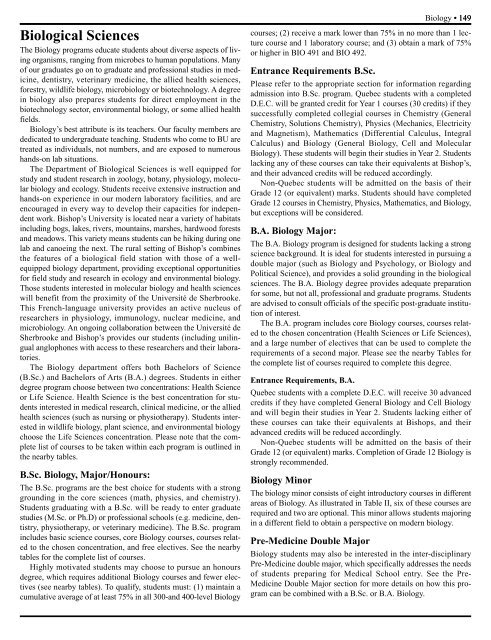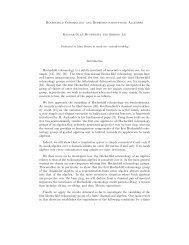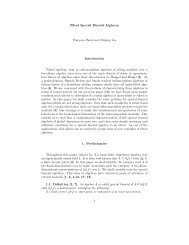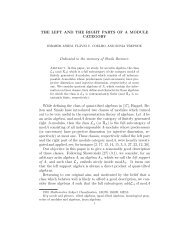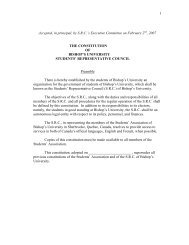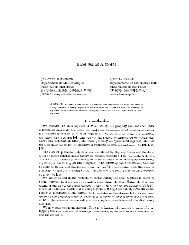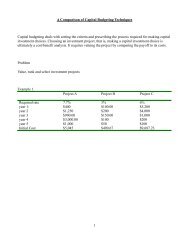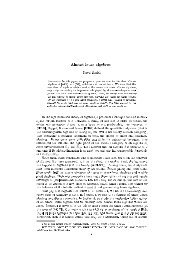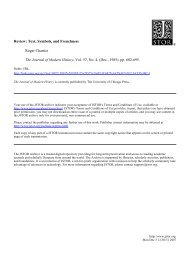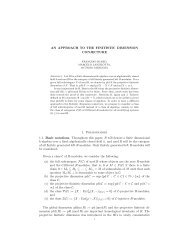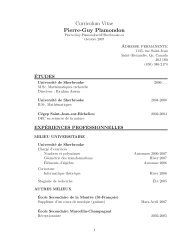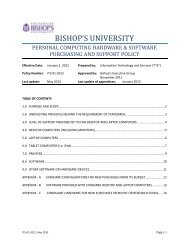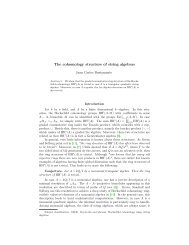Biological Sciences - Bishop's University
Biological Sciences - Bishop's University
Biological Sciences - Bishop's University
Create successful ePaper yourself
Turn your PDF publications into a flip-book with our unique Google optimized e-Paper software.
<strong>Biological</strong> <strong>Sciences</strong><br />
The Biology programs educate students about diverse aspects of living<br />
organisms, ranging from microbes to human populations. Many<br />
of our graduates go on to graduate and professional studies in medicine,<br />
dentistry, veterinary medicine, the allied health sciences,<br />
forestry, wildlife biology, microbiology or biotechnology. A degree<br />
in biology also prepares students for direct employment in the<br />
biotechnology sector, environmental biology, or some allied health<br />
fields.<br />
Biology’s best attribute is its teachers. Our faculty members are<br />
dedicated to undergraduate teaching. Students who come to BU are<br />
treated as individuals, not numbers, and are exposed to numerous<br />
hands-on lab situations.<br />
The Department of <strong>Biological</strong> <strong>Sciences</strong> is well equipped for<br />
study and student research in zoology, botany, physiology, molecular<br />
biology and ecology. Students receive extensive instruction and<br />
hands-on experience in our modern laboratory facilities, and are<br />
encouraged in every way to develop their capacities for independent<br />
work. Bishop’s <strong>University</strong> is located near a variety of habitats<br />
including bogs, lakes, rivers, mountains, marshes, hardwood forests<br />
and meadows. This variety means students can be hiking during one<br />
lab and canoeing the next. The rural setting of Bishop’s combines<br />
the features of a biological field station with those of a wellequipped<br />
biology department, providing exceptional opportunities<br />
for field study and research in ecology and environmental biology.<br />
Those students interested in molecular biology and health sciences<br />
will benefit from the proximity of the Université de Sherbrooke.<br />
This French-language university provides an active nucleus of<br />
researchers in physiology, immunology, nuclear medicine, and<br />
microbiology. An ongoing collaboration between the Université de<br />
Sherbrooke and Bishop’s provides our students (including unilingual<br />
anglophones with access to these researchers and their laboratories.<br />
The Biology department offers both Bachelors of Science<br />
(B.Sc.) and Bachelors of Arts (B.A.) degrees. Students in either<br />
degree program choose between two concentrations: Health Science<br />
or Life Science. Health Science is the best concentration for students<br />
interested in medical research, clinical medicine, or the allied<br />
health sciences (such as nursing or physiotherapy). Students interested<br />
in wildlife biology, plant science, and environmental biology<br />
choose the Life <strong>Sciences</strong> concentration. Please note that the complete<br />
list of courses to be taken within each program is outlined in<br />
the nearby tables.<br />
B.Sc. Biology, Major/Honours:<br />
The B.Sc. programs are the best choice for students with a strong<br />
grounding in the core sciences (math, physics, and chemistry).<br />
Students graduating with a B.Sc. will be ready to enter graduate<br />
studies (M.Sc. or Ph.D) or professional schools (e.g. medicine, dentistry,<br />
physiotherapy, or veterinary medicine). The B.Sc. program<br />
includes basic science courses, core Biology courses, courses related<br />
to the chosen concentration, and free electives. See the nearby<br />
tables for the complete list of courses.<br />
Highly motivated students may choose to pursue an honours<br />
degree, which requires additional Biology courses and fewer electives<br />
(see nearby tables). To qualify, students must: (1) maintain a<br />
cumulative average of at least 75% in all 300-and 400-level Biology<br />
Biology • 149<br />
courses; (2) receive a mark lower than 75% in no more than 1 lecture<br />
course and 1 laboratory course; and (3) obtain a mark of 75%<br />
or higher in BIO 491 and BIO 492.<br />
Entrance Requirements B.Sc.<br />
Please refer to the appropriate section for information regarding<br />
admission into B.Sc. program. Quebec students with a completed<br />
D.E.C. will be granted credit for Year 1 courses (30 credits) if they<br />
successfully completed collegial courses in Chemistry (General<br />
Chemistry, Solutions Chemistry), Physics (Mechanics, Electricity<br />
and Magnetism), Mathematics (Differential Calculus, Integral<br />
Calculus) and Biology (General Biology, Cell and Molecular<br />
Biology). These students will begin their studies in Year 2. Students<br />
lacking any of these courses can take their equivalents at Bishop’s,<br />
and their advanced credits will be reduced accordingly.<br />
Non-Quebec students will be admitted on the basis of their<br />
Grade 12 (or equivalent) marks. Students should have completed<br />
Grade 12 courses in Chemistry, Physics, Mathematics, and Biology,<br />
but exceptions will be considered.<br />
B.A. Biology Major:<br />
The B.A. Biology program is designed for students lacking a strong<br />
science background. It is ideal for students interested in pursuing a<br />
double major (such as Biology and Psychology, or Biology and<br />
Political Science), and provides a solid grounding in the biological<br />
sciences. The B.A. Biology degree provides adequate preparation<br />
for some, but not all, professional and graduate programs. Students<br />
are advised to consult officials of the specific post-graduate institution<br />
of interest.<br />
The B.A. program includes core Biology courses, courses related<br />
to the chosen concentration (Health <strong>Sciences</strong> or Life <strong>Sciences</strong>),<br />
and a large number of electives that can be used to complete the<br />
requirements of a second major. Please see the nearby Tables for<br />
the complete list of courses required to complete this degree.<br />
Entrance Requirements, B.A.<br />
Quebec students with a complete D.E.C. will receive 30 advanced<br />
credits if they have completed General Biology and Cell Biology<br />
and will begin their studies in Year 2. Students lacking either of<br />
these courses can take their equivalents at Bishops, and their<br />
advanced credits will be reduced accordingly.<br />
Non-Quebec students will be admitted on the basis of their<br />
Grade 12 (or equivalent) marks. Completion of Grade 12 Biology is<br />
strongly recommended.<br />
Biology Minor<br />
The biology minor consists of eight introductory courses in different<br />
areas of Biology. As illustrated in Table II, six of these courses are<br />
required and two are optional. This minor allows students majoring<br />
in a different field to obtain a perspective on modern biology.<br />
Pre-Medicine Double Major<br />
Biology students may also be interested in the inter-disciplinary<br />
Pre-Medicine double major, which specifically addresses the needs<br />
of students preparing for Medical School entry. See the Pre-<br />
Medicine Double Major section for more details on how this program<br />
can be combined with a B.Sc. or B.A. Biology.
150 • Bishop’s <strong>University</strong> 2013/2014<br />
B.Sc. Biology (Health <strong>Sciences</strong>)*<br />
1. Y1 Year<br />
(All non-Quebec students; 30 cr)<br />
BIO 196 Introductory Cell & Molecular<br />
Biology<br />
BIO 197 Evolution Of Life<br />
CHM 191 General Chemistry I<br />
CHM 192 General Chemistry II<br />
PHY 193 General Physics I for Life<br />
<strong>Sciences</strong> I<br />
PHY 194 General Physics II for Life<br />
<strong>Sciences</strong> II<br />
MAT 198 Calculus I for Life <strong>Sciences</strong><br />
MAT 199 Calculus II for Life <strong>Sciences</strong><br />
ELA 116 Effective Writing (or other<br />
ENG)<br />
Humanities option (CLA, ENG, HIS,<br />
REL, PHI or Lib. Arts)<br />
2. Required Core Courses (21 cr)<br />
BIO 201 Cell and Molecular Biology<br />
BIO 205 Diversity of Life 1<br />
BIO 206 Diversity of Life 2<br />
BIO 208 Genetics<br />
BIO 336 Animal Physiology 1<br />
CHM 111 Organic Chemistry<br />
PHY 101 Statistical Methods<br />
3. Required Concentration<br />
Courses (18 cr)<br />
BIO 233 Human Anatomy<br />
BCH 313 Metabolism<br />
BIO 337 Animal Physiology 2<br />
BIO 352 Microbiology<br />
PSY 101 Introductory Psychology<br />
PBI 288 Brain and Behavior<br />
4. Concentration Options (21 cr)<br />
Select any 7 courses from the far right column,<br />
including a maximum of 3<br />
Psychology courses (PSY, PMA and/or<br />
PBI).<br />
5. Science Options (6 cr)<br />
Select any 2 courses from the Division of<br />
Natural <strong>Sciences</strong> and Mathematics (including<br />
Biology courses). All courses must be<br />
eligible for Science credit.<br />
6. Free Options (24 cr)<br />
Choose 8 courses from any division to<br />
complete your program. These electives<br />
can be used to fulfill the requirements for a<br />
minor from a different department.<br />
B.Sc. Biology Honours<br />
(Health <strong>Sciences</strong>)<br />
In addition to requirements 1-5 above, add<br />
the following courses and reduce the free<br />
options to 15 cr (5 courses).<br />
BIO 492 Honours Thesis I<br />
BIO 493 Honours Thesis II<br />
BIO 386 Scientific Writing<br />
B.A. Biology (Health <strong>Sciences</strong>)*<br />
1. Y1 Year (All non-Quebec students;<br />
30 cr)<br />
BIO 196 Introductory Cell and Molecular<br />
Biology<br />
BIO 197 Evolution of Life<br />
ELA 116 Effective Writing (or other<br />
ENG)<br />
Humanities option (CLA, ENG, HIS,<br />
REL, PHI or Lib. Arts)<br />
6 free options<br />
2. Required Core Courses (12 cr)<br />
BIO 205 Diversity of Life 1<br />
BIO 206 Diversity of Life 2<br />
BIO 208 Genetics<br />
PHY 101 Statistical Methods<br />
3. Required Concentration<br />
Courses<br />
(12 cr)<br />
BIO 233 Human Anatomy<br />
PSY 101 Introductory Psychology<br />
OR<br />
PBI 288 Brain and Behavior<br />
BIO336 Animal Physiology 1<br />
BIO 337 Animal Physiology 2<br />
4. Concentration Options (18 cr)<br />
Select any 6 courses from the far right column.,<br />
including a maximum of 3<br />
Psychology courses (PSY, PMA, and/or<br />
PBI).<br />
5. Free Options (45 cr)<br />
Choose 15 courses from any division to<br />
complete your program. Consider using<br />
these free options (along with the Y1<br />
options, if applicable) to fulfill requirements<br />
for a second major.<br />
Health <strong>Sciences</strong> Concentration<br />
Options*<br />
BIO 207 General Ecology<br />
BIO 212 Evolution<br />
BIO 319 History of Biology<br />
BIO 394 Biology of Cancer<br />
BIO 442 Bioethics<br />
BIO 393 Evaluating Sci. Evidence<br />
BIO 320 Programmed Cell Death<br />
BIO 428 Adv Physiology<br />
BIO 433 Advanced Exer Phys<br />
BIO 349 Med and Forensic Entomology<br />
BIO 359 Human Genetics<br />
BIO 365 Devel Biology<br />
BIO 391 Experiential Learning<br />
BIO 411 Health Seminar<br />
BCH 210 General Biochemistry<br />
BCH 311 Proteins<br />
BCH 312 Lipids and Membranes<br />
BCH 381 Immunology<br />
BCH 382 Env Biochem and Tox<br />
BCH 383 Molecular Biology<br />
BCH 422 Biotechnology<br />
CHM 141Analytical Chemistry<br />
CHM 211 Organic Chemistry II.<br />
PBI 275 Health Psychology 1<br />
PBI 276 Health Psychology 2<br />
PBI 302 Perception<br />
PBI 388 Brain and Behaviour II<br />
PBI 379 Neuropsychology<br />
PBI 380 Psychopharmacology<br />
PSY 213 Research Methods<br />
PMA 360 Advanced Psychological<br />
Statistics<br />
PMA 460 Multivariate Statistics<br />
PSY 399 Psychology of Drug Addiction<br />
*Please note that many courses have<br />
associated labs, featuring the same<br />
course number and the BIL code, as indicated<br />
in the individual course descriptions.<br />
Lab credits do not count towards<br />
the total credit requirements of the program.<br />
The associated (co-requisite) lab<br />
must be completed to receive credit for<br />
the course.<br />
Table 1: The Health Science Concentration
Biology • 151<br />
B.Sc. Biology (Life <strong>Sciences</strong>)*<br />
1. Y1 Year (All non-Quebec students; 30 cr)<br />
BIO196 Introductory Cell and Molecular Biology<br />
BIO 197Evolution of Life<br />
CHM 191 General Chemistry I<br />
CHM 192 General Chemistry II<br />
PHY 193 General Physics I for Life <strong>Sciences</strong> I<br />
PHY 194 General Physics II for Life <strong>Sciences</strong> II<br />
MAT 198 Calculus I for Life <strong>Sciences</strong><br />
MAT 199 Calculus II for Life <strong>Sciences</strong><br />
ELA 116 Effective Writing (or other ENG)<br />
Humanities option (CLA, ENG, HIS, REL, PHI or Lib. Arts)<br />
2. Required Core Courses (21 cr)<br />
BIO 201 Cell and Molecular Biology<br />
BIO 205 Diversity of Life 1<br />
BIO 206 Diversity of Life 2<br />
BIO 208 Genetics<br />
BIO 336 Animal Physiology 1<br />
CHM 111 Organic Chemistry<br />
PHY 101 Statistical Methods<br />
3. Required Concentration Courses (18 cr)<br />
BIO 207 General Ecology<br />
BIO212 Evolution<br />
BIO 327 Advanced Ecology<br />
OR<br />
BIO 393 Evaluating Experimental Evidence<br />
ESG127 Introduction to Physical Geography<br />
BIO 357 Vascular Plant Systematics<br />
OR<br />
BIO 345 Plant Physiology<br />
BIO 332 Vertebrate Zoology<br />
OR<br />
BIO 329 Invertebrate Zoology<br />
4. Concentration Options (21 cr)<br />
Select any 7 courses from BIO or BCH including Biology cognates<br />
(see page xxx) Only 1 course can be at the 100 level.<br />
5. Science Options (6 cr)<br />
Select any 2 courses from the Division of Natural <strong>Sciences</strong> and<br />
Mathematics (including Biology courses). All courses must be eligible<br />
for Science credit.<br />
6. Free Options (24 cr)<br />
Choose 8 courses from any division to complete your program.<br />
These electives can be used to fulfill the requirements for a minor<br />
from a different department.<br />
B.Sc. Biology Honours (Life <strong>Sciences</strong>)<br />
In addition to requirements 1-5 above, add the following courses<br />
and reduce the free options to 12 cr (4 courses).<br />
BIO 492 Honours Thesis I<br />
BIO 493 Honours Thesis 2<br />
BIO 386 Scientific Writing<br />
BIO 393 Evaluating Experimental Evidence<br />
B.A. Biology (Life <strong>Sciences</strong>)*<br />
1. Y1 Year (All non-Quebec students; 30 cr)<br />
BIO 196 Introductory Cellular and Molecular Biology<br />
BIO 197 Evolution of Life<br />
ELA 116 Effective Writing (or other ENG)<br />
Humanities option (CLA, ENG, HIS, REL, PHI or Lib. Arts)<br />
6 free options<br />
2. Required Core Courses (12 cr)<br />
BIO 205 Diversity of Life 1<br />
BIO 206 Diversity of Life 2<br />
BIO 208 Genetics<br />
PHY 101 Statistical Methods<br />
3. Required Concentration Courses (12 cr)<br />
BIO 207 General Ecology<br />
BIO 212 Evolution<br />
ESG 127 Introduction to Physical Geography<br />
BIO 332 Vertebrate Zoology<br />
OR<br />
BIO 329 Invertebrate Zoology<br />
OR<br />
BIO 345 Plant Physiology<br />
4. Concentration Options (18 cr)<br />
Select any 6 courses from BIO or BCH, including Biology cognates<br />
(see page xxx). Only 1 course can be at the 100 level.<br />
5. Free Options (45 cr)<br />
Choose 15 courses from any division to complete your program.<br />
Consider using these free options (along with the Y1 options, if<br />
applicable) to fulfill requirements for a second major.<br />
Minor in Biology (18 credits)<br />
BIO196 Introductory Cellular and Molecular Biology<br />
BIO 197Evolution of Life<br />
BIO 205 Diversity of Life 1<br />
BIO 206 Diversity of Life 2<br />
BIO 207 Ecology<br />
BIO 208 Genetics<br />
Two additional Biology courses<br />
*Please note that many courses have associated labs, featuring the<br />
same course number and the BIL code, as indicated in the individual<br />
course descriptions. Lab credits do not count towards the total<br />
credit requirements of the program. The associated (co-requisite)<br />
lab must be completed to receive credit for the course.<br />
Table 2: The Life Science Concentration
152 • Bishop’s <strong>University</strong> 2013/2014<br />
COURSES<br />
PLEASE NOTE: The following list of courses represents those<br />
courses which are normally offered by the Department of <strong>Biological</strong><br />
<strong>Sciences</strong>. However, some courses alternate and thus are only available<br />
every second year. The schedule of such courses is indicated<br />
below the course description. Some courses that are not required in<br />
Biology programs are not offered on a regular basis. Such courses<br />
are indicated with an asterisk (*).<br />
BIO 111 Organic Gardening 3-3-0<br />
This course is an introduction to organic and environment-friendly gardening, combining<br />
lectures and a hands-on-practicum. Principles of companionship, growth, water<br />
and mineral balance will be discussed. Students will learn how to recognize and treat<br />
diseases, pests or common physiological disorders with environmentally natural techniques.<br />
At the end of this course, students should be able to set-up and run a garden<br />
using environment-friendly techniques and know how to harvest, handle and store<br />
crops. Depending on the interests of the group, the course will either cover transformation<br />
strategies for year-long storage of vegetables grown in the summer (canning,<br />
freezing, fermentation, drying…), or make an introduction to entrepreneurship in<br />
organic farming (based on the instructor’s own experience). In addition, several visits<br />
will be organized to locally run organic farms to present various models of environment-friendly<br />
productions of veggies, fruits and herbs.<br />
Note: This course is open to the general public and may be taken by non-DNS students<br />
for science credit. However, students in any of the science majors may only take this<br />
course as a free elective, and may not count this course for science credit. It is offered<br />
in the summer semester.<br />
Co-requisite: BIL 111<br />
BIL 111 Organic Gardening Lab 1-0-3<br />
This is the practical component of the course, where students will apply in practice<br />
what they have discussed in lecture and actually grow and harvest their own crops.<br />
Depending on the interest of the class, students will also be expected to either process<br />
and preserve their crops for long term storage, or set-up a long term strategy for their<br />
own hypothetical organic garden.<br />
Co-requisite: BIO 111<br />
BIO 131 The Human Body in Health and Disease 3-3-0<br />
An introduction to human anatomy and physiology. This course will employ problembased<br />
learning, virtual experiments, and traditional lectures to explain the relationship<br />
between the structure of the human body and its functions. These concepts will then<br />
be applied to the study of representative human diseases. This course is designed for<br />
students with minimal biology backgrounds, including arts students, teachers, coaches,<br />
and home-care workers. Students will acquire a working knowledge of human biology<br />
and the ability to communicate this knowledge to others.<br />
Prerequisites: Secondary school Biology and/or Chemistry recommended<br />
Note: This course cannot be taken for credit by students in Biology or Biochemistry or<br />
by students with credit for BIO 233<br />
Professor Hull<br />
BIO 193b Introductory Biology for Education Students 3-3-0<br />
BIO193b has essentially the same course content as BIO194a but is designed for education<br />
students to provide them with the necessary biological knowledge for teaching<br />
biology in the school system.<br />
This course cannot be taken for credit by anyone who already has credit for BIO<br />
191,BIO 194, BIO 196, BIO197, BIO 199 or PBI 191.<br />
Prerequisites: Secondary school Biology and/or Chemistry are recommended<br />
Co-requisite: BIL 193b<br />
Staff<br />
BIL 193b Introductory Biology Laboratory<br />
for Education Students 1-0-3<br />
Exercises and experiments in Introductory Biology, designed for Education students.<br />
This course cannot be taken for credit by anyone who already has credit for BIL 191 or<br />
BIL199.<br />
Co-requisite: BIO 193b<br />
Staff<br />
BIO 194 Introductory Biology for the Social and Human <strong>Sciences</strong> 3-3-0<br />
This course provides an introduction to biology for students without a strong science<br />
background. Topics include: Scientific method, chemistry of life, cell structure, cell<br />
metabolism, photosynthesis, transport systems, origin of life, evolution, genetics, reproduction,<br />
taxonomy, diversity of life (including microorganisms, fungi, plants and animals),<br />
ecosystems. this course cannot be taken for credit by students in a B.Sc. program<br />
of B.A. Biology. It is not a sufficient prerequisite for more advanced Biology<br />
courses.<br />
Prerequisites: Secondary school Biology and/or Chemistry are recommended.<br />
This course cannot be taken for credit by anyone who already has credit for collegial<br />
Biology NYA, BIO 191, BIO 193, BIO 196, BIO 197, BIO 199 or PBI 191.<br />
BIO 196a Introduction to Cellular and Molecular Biology 3-3-0<br />
Topics covered include: chemistry of life; structure and function of biomolecules; structure<br />
and organization of cells; structure and function of organelles, genetic replication<br />
and expression; gene mutation; cell signaling; regulation of the cell cycle. This course<br />
is intended for B.Sc. students and B.A. (Biology) students; other students are encouraged<br />
to take BIO 194b (The Study of Life).<br />
Prerequisite: High School Biology and Chemistry<br />
This course cannot be taken for credit by anyone who already has credit for collegial<br />
General Biology 2/00XU, Biology 191, Biology 193, Biology 199 or PBI 191<br />
Corequisite: BIL 196a<br />
Professor Chamoux<br />
BIL 196a Introduction to Cellular and Molecular Biology Laboratory1-0-3<br />
Practical exercises in microscopy, molecular and cellular biology, and histology.<br />
Prerequisites: High School Biology and Chemistry; Co-requisite: BIO 196a<br />
Staff<br />
BIO 197b The Evolution of Life 3-3-0<br />
This course will explore evolution and how it has helped shape our understanding of the<br />
natural world around us. It will start by looking at how the theory of evolution by natural<br />
selection came about. Natural selection and speciation will then be explored in<br />
greater detail, with a particular focus on species interactions and how these help to form<br />
the complex web of ecological relationships that help maintain biological systems<br />
today. The course will then conclude with a brief history of life on earth, from the earliest<br />
known life, through a repeated series of mass extinctions and adaptive radiations,<br />
to the present biomes and biodiversity we know today. This course is intended for B.Sc.<br />
students and B.A. (Biology) students; other students are encouraged to take BIO 194b<br />
(The Study of Life).<br />
Prerequisite: BIO 196a or consent of the instructor.<br />
This course cannot be taken for credit by anyone who already has credit for collegial<br />
Biology NYA, Biology 191, Biology 193, Biology 194, Biology 199, PBI 191 or Biology<br />
212.<br />
Professor Richardson<br />
BIO 201a Cellular and Molecular Biology 3-3-0<br />
Topics in modern cell biology. Examines aspects of eukaryotic cell structure and function.<br />
Includes, but not restricted to, areas such as intracellular signaling, cell cycling<br />
and cancer, cell-matrix interactions, endo/exocytosis, protein targeting and organelle<br />
biogenesis.<br />
Prerequisites: BIO 191 or BIO 196a or collegial general Biology 2/00XU<br />
This course may not be taken for credit by anyone who already has credit for Biology<br />
110.<br />
Professor Chamoux<br />
BIO 205a Diversity of Life I 3-3-0<br />
This course offers a thorough exploration of one branch of the tree of life, that occupied<br />
by multicellular animals. The course complements Diversity of Life II, a winter-term<br />
course with a focus on prokaryotic and non-animal eukaryotic life. The material in both<br />
courses is organized according to a modern phylogenetic framework. In this course students<br />
will learn about phylogenetic hypotheses and evidence, and they will study how<br />
classifications are created, tested, and, where necessary, rejected. Focusing on animals,<br />
we will discuss many of the morphological and physiological adaptations that have<br />
arisen. The evolutionary implications of some features, such as bilateral symmetry and<br />
the notochord, will be discussed more thoroughly. Recent advances as well as current<br />
contentious issues in animal classification will also be examined.<br />
Prerequisite: BIO 191 or BIO 197 or equivalent; Co-requisite: BIL 205a<br />
Students with credit for BIO 115 cannot also receive credit for BIO 205.<br />
Professor Savage<br />
BIL 205a Diversity of Life I Laboratory 1-0-3<br />
The classification, identification, morphology and biology of the animals considered<br />
in BIO 205a.<br />
Co-requisite: BIO 205a<br />
Students with credit for BIL 115 cannot also receive credit for BIL 205.<br />
Professor Boulet
Biology • 153<br />
BIO 206b Diversity of Life II 3-3-0<br />
Like its companion course BIO 205a, this course explores the tree of life, but from a<br />
less animal-centric view. We study the prokaryotes at the root of the tree, responsible<br />
for more than half of the earth’s biomass. Next, we examine the branch that contains all<br />
fungi (and lichens). The various protists and those algae that are not related to green<br />
plants form other branches, which we will also explore. Finally, we study in more detail<br />
the largest group of eukaryotes by biomass, the green plants. The material in this course<br />
(and in BIO 205a) is organized according to a modern phylogenetic framework. The<br />
focus will be on diversity, function and ecological importance. In the case of the green<br />
plants, we look at the reasons for the tremendous ecological success of this form of life.<br />
We examine photosynthesis, transport, reproduction and life cycles, and evolution,<br />
empathizing ecological relevance.<br />
Prerequisite: BIO 191 or BIO 197;Co-requisite: BIL 206b<br />
Students with credit for BIO 116 cannot also receive credit for BIO 206.<br />
Professor van Hulst<br />
BIL 206b Diversity of Life II Laboratory 1-0-3<br />
A series of experiments and exercises to complement BIO 206b.<br />
Co-requisite: BIO 206b<br />
Students with credit for BIL 116 cannot also receive credit for BIL 206.<br />
Staff<br />
BIO 207a General Ecology 3-3-0<br />
An introduction to modern ecology: environmental patterns, patterns in the distribution<br />
of plants and animals, evolution and adaptation, ecosystem function, plant and animal<br />
populations, species interactions, community organization, applied ecology.<br />
Prerequisite: BIO 191 or BIO 197; Co-requisite: BIL 207a<br />
Students with credit for BIO 117 cannot also receive credit for BIO 207.<br />
Professor van Hulst<br />
BIL 207a General Ecology Laboratory 1-0-3<br />
Experiments and exercises in General Ecology.<br />
Co-requisite: BIO 207a<br />
Students with credit for BIL 117 cannot also receive credit for BIL 207.<br />
Professor van Hulst<br />
BIO 208b Genetics 3-3-0<br />
An introduction to the study of biologically inherited traits from three perspectives. (i)<br />
Mendelian Genetics: the rules of genetic transmission and heredity. (ii) Molecular<br />
Genetics: the biochemical and chromosomal basis of heredity. (iii) Population & Evolutionary<br />
Genetics: the variation in genes amongst individuals and populations, heritability,<br />
and changes in genes over time.<br />
Prerequisite: BIO 110 or BIO 196; Co-requisite: BIL 208b<br />
Students with credit for BIO 118 cannot also receive credit for BIO 208.<br />
Professor Boulet<br />
BIL 208b Genetics Laboratory 1-0-3<br />
Experiments in genetics designed to complement topics discussed in BIO 208b.<br />
Co-requisite: BIO 208b<br />
Staff<br />
BIO 212b Evolution 3-3-0<br />
Possibly the greatest single theory in modern science, evolution influences all aspects<br />
of biology from wildlife management to modern medicine. This course will examine<br />
both the patterns of evolution as well as the mechanism.<br />
Prerequisite: BIO 191a or BIO 197b<br />
Professor Richardson<br />
BIO 233 Human Anatomy 3-3-0<br />
The anatomy of all of the major body systems will be discussed in the context of human<br />
health and disease. This course is designed for students interested in the biomedical<br />
sciences or health education. Students will develop their understanding of human anatomy<br />
and will acquire the ability to communicate scientific concepts to their patients or<br />
students.<br />
Prerequisite or Corequisite: BIO 191 or BIO 196<br />
Corequisite: BIL 233. This course cannot be taken for credit by anyone who already<br />
has credit for BIO 131, BIO 132, or BIO 133<br />
Professor Hull<br />
BIL 233 Human Anatomy Lab 1-0-3<br />
This course will give students a solid grounding in vertebrate anatomy through dissections<br />
and preserved material. Dissection material will include either in part or whole,<br />
several mammalian species including sheep, cat, cow, and pig. Material will focus on<br />
the recognition and development of the major organs and systems such as the skeletal,<br />
muscle, nervous, reproductive, excretory, and digestive systems. Although general<br />
mammalian structure will be examined, the relevance of these structures to human<br />
anatomy will represent the major focus of the course.<br />
Corequisite: BIO 233<br />
Students with credit for BIL 133 cannot receive credit for BIL 233<br />
*BIO 245a Field Biology I* 4-5-30<br />
An intensive, three-week long course in which participants study a wide range of habitats<br />
to gain familiarity with plants and animals in the field and to learn methods of field<br />
study. Physical aspects of the environment relating to the biota are studied, as well as<br />
the plants and animals and their interactions with one another and their environment.<br />
Living organisms are brought to the laboratory for further study. Instruction is given<br />
five full days per week during a three-week period. Areas of instruction: Mosses and<br />
Lichens; Terrestrial Mammals; Insects.<br />
Prerequisite: Bio 191 or BIO 197or equivalent<br />
Staff<br />
BIO 319 History of Biology 3-3-0<br />
An outline of biological discovery from early times to the present in relation to social,<br />
historical and cultural developments.<br />
Prerequisites: BIO 205 and BIO 208<br />
Students with credit for BIO 220 cannot receive credit for BIO 319.<br />
Staff<br />
BIO 320a Programmed Cell Death 3-3-0<br />
Programmed cell death, also called apoptosis, is a normal physiological process that<br />
takes place in every type of cell in the animal kingdom. It plays a critical role in embryo<br />
development, in selective processes (immune system), in degenerative diseases and in<br />
cancer. Since the early 90’s, programed cell death is one of the fastest growing subject<br />
of research, with almost 15000 scientific publications in 2004. In this course, we will<br />
explore normal and impaired mechanisms involved in cell death, through examples<br />
taken in human medicine or in invertebrates’ development.<br />
Prerequisite: BIO 201 or BIO 110<br />
Offered in even-numbered winters<br />
Professor Chamoux<br />
BIO 321b Biogeography 3-3-0<br />
The main goals of this course are to study spatial patterns of biodiversity and to attempt<br />
to reconstruct the origin and the present distribution of both extinct and extant taxa. We<br />
start by examining the modern distribution of selected groups of plants and animals, as<br />
well as the distribution and limits of the major biomes. We proceed with an overview<br />
of the major changes in the earth’s climate and topology through geological times, and<br />
conclude with the impact of these historical changes on the evolution and the distribution<br />
of plants and animals. Techniques in biogeographical analysis will be taught and<br />
the students are expected to carry out a group project on the biogeographic history of<br />
a specific group of plants or animals. Topics such as extinction, adaptive radiation and<br />
island biogeography will also be covered.<br />
Prerequisite: BIO 205a<br />
Pre or Co-requisite: BIO 212 or BIO 197<br />
Students with credit for BIO 221 cannot receive credit for BIO 321.<br />
Offered in odd-numbered winters<br />
Professor Savage<br />
BIO 327b Advanced Ecology 3-3-0<br />
A second course in ecology that focuses on understanding relations between animals,<br />
plants, and microbes. Topics include: population growth and regulation, variation in<br />
space and time, predation (including herbivory and adaptations to avoid being eaten),<br />
parasitism and disease, symbiosis and mutualism, life history variation, regulation and<br />
manipulation of abundance, disturbance, food webs, colonization, conservation, and<br />
population viability analysis.<br />
Prerequisite: BIO 207a; Co-requisite BIL 327b<br />
Students with credit for BIO 217 cannot receive credit for BIO 327.<br />
Offered in odd-numbered autumns<br />
Professor van Hulst<br />
BIL 327b Advanced Ecology Laboratory 1-0-3<br />
Laboratory exercises to accompany Advanced Ecology. We will use 10 exercises in<br />
conservation biology using the computer application RAMAS EcoLab. These incorporate<br />
real-world ecological problems, and will give the student experience in dealing<br />
with complex systems, as well as teaching valuable notions in applied ecology.<br />
Co-requisite: BIO 327b<br />
Students with credit for BIL 217 cannot receive credit for BIL 327.<br />
Professor van Hulst
154 • Bishop’s <strong>University</strong> 2013/2014<br />
BIO 329b Invertebrate Zoology 3-3-0<br />
Morphology, physiology, embryology, evolution and classification of invertebrate animals.<br />
Prerequisite: BIO 205a; Co-requisite: BIL 329b<br />
Students with credit for BIO 248 cannot also receive credit for BIO 329.<br />
Professor Savage<br />
BIL 329b Invertebrate Zoology Laboratory 1-0-3<br />
The classification, identification, morphology and biology of the animals considered<br />
in BIO 329b.<br />
Co-requisite: BIO 329b<br />
Students with credit for BIL 248 cannot also receive credit for BIL 329.<br />
Professor Savage<br />
BIO 330* Ornithology 3-3-0<br />
An introduction to the study of birds, including their structure, function, reproduction,<br />
evolution and classification. The integration of morphological, physiological, and<br />
behavioral adaptations will be emphasized. In addition, topics of particular relevance to<br />
birds such as mechanisms of flight, migration, vocal communication, and conservation<br />
will be discussed.<br />
Prerequisite: BIO 205a; Co-requisite: BIL 330<br />
Staff<br />
BIL 330* Ornithology Laboratory 1-0-3<br />
Study of bird morphology using preserved specimens and museum study skins. Field<br />
trips will be used to learn about living birds and their identification.<br />
Prerequisite: BIO 205a; Co-requisite: BIO 330<br />
Staff<br />
BIO 331a* Freshwater Biology 3-3-0<br />
This course will expose students to the biological importance and diversity of freshwater<br />
systems. Class material will look at both the biotic and abiotic components of<br />
aquatic systems as well as their interactions.<br />
Prerequisite or Co-requisite: BIO 205a; BIO 207a; Co-requisite: BIL 331a<br />
Students with credit for BIL 230 cannot also receive credit for BIL 331.<br />
Professor Richardson<br />
BIL 331a* Freshwater Biology Lab 1-3-0<br />
The lab section will focus on the different techniques necessary for sampling both lentic<br />
and lotic systems. Emphasis will be placed on practical first-hand experience using the<br />
appropriate equipment in the field. The process of data collection will culminate in the<br />
students performing a mini-research project on a local aquatic system of their choice<br />
and presenting these data to their peers.<br />
Prerequisite or Co-requisite: BIO 205a; BIO 207a; Co-requisite: BIO 331a<br />
Students with credit for BIL 230 cannot also receive credit for BIL 331.<br />
Professor Richardson<br />
BIO 332a Vertebrate Zoology 3-3-0<br />
Evolution, classification, morphology, and physiology of the various classes of vertebrates.<br />
Particular attention will be placed upon the integumentary, skeletal, muscular,<br />
respiratory, digestive, excretory, and reproductive systems.<br />
Prerequisite: BIO 205a; Co-requisite BIL 332a<br />
Students with credit for BIO 270 cannot also receive credit for BIO 332.<br />
Professor Richardson<br />
BIL 332a Vertebrate Zoology Laboratory 1-0-3<br />
The lab component will expose students to the diversity of vertebrates around them.<br />
Vertebrate diversity and behavior will be studied through a series of field trips, while<br />
basic anatomy will be examined in more detail in the lab through dissections and preserved<br />
mounts.<br />
Prerequisite: BIO 205a; Co-requisite: BIO 332a<br />
Students with credit for BIL 270 cannot also receive credit for BIL 332.<br />
Professor Richardson<br />
BIO 336a Animal Physiology I 3-3-0<br />
Basic mechanisms of homeostatic regulation. Topics include: Cell physiology, Nervous<br />
system, Muscular system, and the Cardiovascular system.<br />
Prerequisite: BIO 197 or BIO 110; Co-requisite: BIL 336a<br />
Students who have received credit for BIO 226a cannot also receive credit for<br />
BIO 336a.<br />
Professor Hull<br />
BIL 336a Animal Physiology I Laboratory 1-0-3<br />
Experiments designed to examine the physiological systems discussed in BIO 336a.<br />
Co-requisite: BIO 336a<br />
Students who have received credit for BIL 226 cannot also receive credit for BIL 336.<br />
Professor Hull<br />
BIO 337b Animal Physiology II 3-3-0<br />
Mechanisms of functional operation of animal organisms. Topics include: renal, respiratory,<br />
gastrointestinal, and reproductive function.<br />
Prerequisite: BIO 336a; Co-requisite: BIL 337b<br />
Students who have received credit for BIO 228 cannot also receive credit for BIO 337.<br />
Professor Hull<br />
BIL 337b Animal Physiology II Laboratory 1-0-3<br />
Experiments dealing with different aspects of animal physiology. Some experiments<br />
will be performed using computer simulations.<br />
Co-requisite: BIO 337b<br />
Students who have received credit for BIL 228 cannot also receive credit for BIL 337.<br />
Professor Hull<br />
BIO 345b Plant Physiology 3-3-0<br />
Nutrition, transport, growth and development in plants; the water relations of plants;<br />
mineral nutrition; growth regulators; tropisms; photoperiodism; vernalization and dormancy.<br />
Prerequisite: BIO 206b<br />
Offered in odd-numbered winters<br />
Professor van Hulst<br />
BIO 349a Medical and Forensic Entomology 3-3-0<br />
As one of the most important group of disease vectors, insects and other arthropods are<br />
involved in the transmission of numerous pathogens causing diseases such as malaria,<br />
the plague, sleeping sickness, scabies, West Nile fever, and Lyme disease. This course<br />
will introduce students to some of the basic concepts of medical entomology with a<br />
focus on selected diseases. Information on the life cycles of insect vectors and the<br />
pathogens they carry is presented, as well as symptoms, treatment and geographical<br />
distribution of selected arthropod-borne diseases. The relevance of entomological evidence<br />
in criminal investigations (such as the use of insects to determine post-mortem<br />
interval is also discussed.<br />
Prerequisite BIO 205a<br />
Offered in odd-numbered autumns.<br />
Professor Savage<br />
BIO 350* Invertebrate Physiology 3-3-0<br />
This course provides an overview of some physiological mechanisms of invertebrates<br />
including digestion and nutrition, respiration, excretion, reproduction, circulation, locomotion,<br />
and behavior. We will also consider some of the unique strategies used by<br />
invertebrates which allow them to thrive in Earth’s most extreme and challenging environments:<br />
deserts, frozen wastelands, deep ocean floors, hot vents, inside other organisms,<br />
and hypersaline lakes.<br />
Prerequisite: BIO 105a<br />
Professor Savage<br />
BIO 352a Microbiology 1-0-3<br />
An introduction to prokaryotic microorganisms, eukaryotic microorganisms, and viruses;<br />
their ecology, growth characteristics, and host interactions. Examination of the environmental<br />
roles of microbes as well as their impact on the human world.<br />
Prerequisite: BIO 195a; Co-requisite: BIL 352a<br />
Offered in odd-numbered autumns.<br />
Professor Stroeher<br />
BIL 352a Microbiology Laboratory 1-0-3<br />
An introduction to common microbiological techniques used in medical, biological and<br />
biochemical research, including techniques in growth, staining and identification of<br />
bacteria and viruses. As well, the diversity of physiological and metabolic requirements<br />
of bacteria will be examined.<br />
Co-requisite: BIO 352a<br />
Offered in odd-numbered autumns<br />
Professor Stroeher<br />
BIO 354 Insect Biodiversity 3-3-0<br />
With close to a million described species, insects form more than 70% of animal diversity.<br />
But in spite of such overwhelming diversity they are poorly known and consequently<br />
often excluded from biodiversity studies. The main goal of this course is to teach the students<br />
how to collect, preserve and identify insects, especially those found in eastern North<br />
America. In addition to using material housed in the Bishop’s insect collection, material<br />
collected in the field by each student will be prepared in a fashion that will make the spec-
Biology • 155<br />
imens museum worthy. Through the collecting and identification process, students will<br />
learn about insect taxonomy but they will also learn about where different taxa can be<br />
found and what their general ecological requirements are. Once they have competed the<br />
course, students should be able to identify most commonly encountered insects at least to<br />
the family level and recognize those that are beneficial or potentially harmful.<br />
Prerequisite: BIO 205a<br />
Offered in even-numbered autumns<br />
Professor Savage<br />
BIO 357a Vascular Plant Systematics 3-3-0<br />
Evolution, taxonomy, morphology, and anatomy of the vascular plants.<br />
Prerequisite: BIO 206b; Co-requisite: BIL 357a<br />
Offered in even-numbered winters<br />
Students with credit for BIO 257 cannot also receive credit for BIO 357.<br />
Professor van Hulst<br />
BIL 357a Vascular Plant Systematics Laboratory 1-3-0<br />
Exercises in identification and classification of vascular plants: use of floras and identification<br />
keys, computer keys, and programs for numerical classification; morphology<br />
and anatomy of vascular plants.<br />
Co-requisite: BIO 357a<br />
Students with credit for BIL 257 cannot also receive credit for BIL 357.<br />
Professor van Hulst<br />
BIO 358b Animal Behaviour 3-3-0<br />
The study of animal behaviour represents the oldest known form of biological study.<br />
Even from our earliest beginnings, humans had an intense interest in understanding<br />
how animals behave. This interest is still evident from our almost instinctive need to<br />
share our homes with various pets. This course will build on this most basic need to<br />
watch and understand animal behaviour, but will do so from a more scientific approach.<br />
Prerequisite: BIO 205a, BIO 207a; Co-requisite: BIL 358b<br />
Offered in odd-numbered winters<br />
Professor Richardson<br />
BIL 358b Animal Behaviour Labs 1-0-3<br />
Using videos and experimental labs, students will further explore many of the concepts<br />
and topics discussed in the class.<br />
Co-requisite: BIO 358b<br />
Offered in odd-numbered winters.<br />
Professor Richardson<br />
BIO 359a Human Genetics 3-3-0<br />
Cytogenetics, biochemical genetics, Mendelian genetics, molecular genetics and quantitative<br />
genetics of humans; chromosome mapping; genetics and medicine.<br />
Prerequisite: BIO 208b<br />
Offered in even-numbered autumns<br />
Staff<br />
BIO 365b Developmental Biology 3-3-0<br />
Examination of the molecular events involved in the development of vertebrates, invertebrates<br />
and plants, emphasizing common strategies used in these three systems. Topics will<br />
include establishment of body axes, origin of germ layers, and segmental pattern formation.<br />
The role of developmental genes, regulatory gene families, and maternal effect genes will<br />
be emphasized. Morphogenesis and early cell differentiation will also be studied.<br />
Prerequisite: BIO 196a or BIO 110; BIO 208b<br />
Offered in even-numbered winters<br />
Professor Stroeher<br />
*BIO 367a Ichthyology: The World of Fishes 3-3-0<br />
A survey of fishes of the world. Fish taxa representing freshwater, marine, temperate,<br />
tropical and deep sea forms will be examined in terms of their morphology, phylogeny,<br />
behaviourial ecology and community structure. Adaptations associated with the successful<br />
occupation of diverse aquatic habitats within the group as a whole will be discussed.<br />
In addition, within-taxa global distribution patterns will be examined in light of<br />
current theories regarding plate tectonics and zoogeography.<br />
Prerequisite: BIO 205a; Co-requisite: BIL 367a<br />
Professor Richardson<br />
BIL 367a Ichthyology Laboratory 1-0-3<br />
The identification of fishes, with the use of keys based on the characteristics of major<br />
groups. Practical techniques will include the preservation, clearing and staining of<br />
whole fishes for skeletal features. Other laboratory exercises will include examinations<br />
of fish anatomy, behaviour and development.<br />
Prerequisite: BIO 205a; Co-requisite: BIO 367a<br />
Offered in even-numbered years<br />
Professor Richardson<br />
BIO 386a Scientific Writing for the Life <strong>Sciences</strong> 3-3-0<br />
Lectures will introduce the scientific method and train students to critically read the<br />
scientific literature. Detailed examples of a written paper will then follow with stepby-step<br />
instructions. Data analysis, word processing and citation methods will be<br />
reviewed. In addition to written manuscripts, poster and oral presentations will be discussed.<br />
Prerequisite: This course is normally open to Y3 or Y4 students by permission of<br />
departmental chair or instructor.<br />
Students with credit for BIO 272 cannot also receive credit for BIO 386.<br />
Staff<br />
BIO 391<br />
Experiential Learning in Health Science<br />
and Molecular Biology 3-3-0<br />
Students in the Health Science or Molecular Biology program may receive credit for<br />
working under the tutelage of a mentor in a field directly related to their area of study.<br />
Students must secure both an internal supervisor (a fulltime faculty member) and a suitable<br />
mentor (i.e. external supervisor who will supervise the day to day activities of the<br />
student). Students must be actively involved in the daily work and should not be acting<br />
as menial labor.<br />
Assessment of the student will be based largely on a mark assigned by the mentor<br />
directly responsible for the student and the submission of a journal outlining the daily<br />
objectives and actual work itself. Projects may be intensive in nature (i.e. 3 weeks during<br />
the summer), or may be more drawn out (i.e. 6-8 hours every week during the<br />
semester).<br />
This course is only eligible to students in good standing and if available positions are<br />
available. Students may not work for salary and may not work concurrently in an area<br />
directly related to their honors project.<br />
Note: Students may only take one experiential learning course for credit (i.e. BIO 391<br />
or BIO 392 or ELP 300).<br />
Coordinator: Professor Savage<br />
BIO 392<br />
Experiential Learning in Diversity<br />
and Environmental Biology 3-3-0<br />
Students in the Diversity Form and Function or the Environmental Biology program<br />
may receive credit for working under the tutelage of a mentor in a field directly related<br />
to their area of study. Students must secure both an internal supervisor (a fulltime<br />
faculty member) and a suitable mentor (i.e. external supervisor who will supervise the<br />
day to day activities of the student). / Students must be actively involved in the daily<br />
work and should not be acting as menial labor.<br />
Assessment of the student will be based largely on a mark assigned by the mentor<br />
directly responsible for the student and the submission of a journal outlining the daily<br />
objectives and actual work itself. Projects may be intensive in nature (i.e. 3 weeks during<br />
the summer), or may be more drawn out (i.e. 6-8 hours every week during the<br />
semester).<br />
This course is only eligible to students in good standing and if available positions are<br />
available. Students may not work for salary and may not work concurrently in an area<br />
directly related to their honors project.<br />
Note: Students may only take one experiential learning course for credit (i.e. BIO 391,<br />
or BIO 392 or ELP 300).<br />
Coordinator: Professor Savage<br />
BIO 393a Evaluating Scientific Evidence 3-3-0<br />
In science we often have to decide whether data favor one hypothesis or another. This<br />
is easy if our evidence excludes all but one hypothesis. In practice we often face a harder<br />
task: several hypotheses remain that are compatible with the data, although one may<br />
seem the more “likely” one. How de we evaluate which one is more likely in the light<br />
of the data, and what exactly does “more likely” mean here? This course examines tools<br />
designed to help us in selecting the hypothesis that receives most support from the data:<br />
Neyman-Pearson P-values, Fisherian P-values, Bayesian posterior probabilities, confidence<br />
intervals, Bayesian credible intervals, and information-based criteria like AIC<br />
and BIC. You will learn how to calculate and how to interpret P-values and true measures<br />
of evidence, and how to use them in your own research.<br />
Prerequisite: PHY101a<br />
Offered in even-numbered autumns<br />
Students with credit for BIO 291 cannot also receive credit for BIO 393.<br />
Professor van Hulst
156 • Bishop’s <strong>University</strong> 2013/2014<br />
BIL 393a Planning and Analysis of<br />
<strong>Biological</strong> Experiments Laboratory 1-0-3<br />
The laboratory provides hands-on training in setting up experiments and analyzing their<br />
results using the open-source statistical language R. This is widely used in both academic<br />
and industrial settings, is powerful, and is freely available. It provides many tools<br />
for experimental design, data analysis, and graphical presentation.<br />
Corequisite: BIO393a<br />
Students with credit for BIL 291 cannot also receive credit for BIL 393.<br />
Professor van Hulst<br />
BIO 394b Biology of Cancer 3-3-0<br />
This course will review the broad subject of cancer development and treatment. In particular<br />
it will focus on taking concepts seen in cell biology and applying them to cancer<br />
cells. Among the topics reviewed will be: cancer types and staging, mutation rates<br />
and environmental contributions to genetic changes, oncogenes and tumor suppressors,<br />
cell proliferation/death balance, modification of cancer cells phenotypes and metastases<br />
formation, role of the immune system in the prevention of cancer spreading,<br />
strategies of cure, and a review of the body’s physiological responses to several forms<br />
of cancer.<br />
Prerequisites: BIO 336 AND either BIO 110 or BIO 201<br />
Offered in odd-numbered winters<br />
Students with credit for BIO 224 cannot receive credit for BIO 394<br />
Professor Chamoux<br />
BIO 411b Seminars in Health <strong>Sciences</strong> 3-3-0<br />
An advanced course discussing current topics in the Health <strong>Sciences</strong>. Students will be<br />
expected to critically evaluate recent scientific literature, prepare and deliver oral and<br />
written presentations, participate in discussions, and analyze research questions.<br />
Pre-requisites: BIO 208 AND BIO 336<br />
Restricted to students in year 3 or 4 (i.e. with less than 60 credits remaining of a B.Sc.<br />
Biology degree)<br />
BIO 412* Special Topics in Ecology and Conservation 3-3-0<br />
This course will discuss recent developments in specific areas of ecology, conservation,<br />
and/or zoology. The course content will vary from year to year, depending on the<br />
instructor’s area of expertise and the students’ interests.<br />
Prerequisite: BIO 205a, BIO 207a<br />
Students with credit for BIO 362 cannot also receive credit for BIO 412.<br />
Staff<br />
BIO 421a Independent Studies in Biology I 3-1-3<br />
This course is intended for final-year students who wish to pursue in-depth study of<br />
a particular area of biology or who have a special need for a biology course that would<br />
otherwise not be available during their final semester of course work. This course can<br />
only be done in close collaboration with a faculty advisor from within the Department<br />
of <strong>Biological</strong> <strong>Sciences</strong>, and may not be used as a supplement to a student’s honours<br />
project. Requirements for this course will be agreed upon by at least three professors<br />
from within the Department of <strong>Biological</strong> <strong>Sciences</strong>.<br />
Pre-requisite: Consent of a member of the Department of <strong>Biological</strong> <strong>Sciences</strong><br />
Students with credit for BIO 371 cannot also receive credit for BIO 421.<br />
Coordinator: Professor Savage<br />
BIO 422b Independent Studies in Biology II 3-1-3<br />
This course represents an additional semester of independent work, either a continuation<br />
of or a separate course from BIO 421a, meant for final-year students who wish to<br />
pursue in-depth study of a particular area of biology or who have a special need for a<br />
biology course that would otherwise not be available during their final semester of<br />
course work. This course can only be done in close collaboration with a faculty advisor<br />
from within the Department of <strong>Biological</strong> <strong>Sciences</strong>, and may not be used as a supplement<br />
to a student’s honours project. Requirements for this course will be agreed<br />
upon by at least three professors from within the Department of <strong>Biological</strong> <strong>Sciences</strong>.<br />
Pre-requisite: Consent of a member of the Department of <strong>Biological</strong> <strong>Sciences</strong><br />
Students with credit for BIO 372 cannot also receive credit for BIO 422.<br />
Coordinator: Professor Savage<br />
BIO 428b Advanced Physiology 3-3-0<br />
This course will examine how animals adapt to environmental stresses such as extremes<br />
of temperature of altitude, hypoxia, water limitation and dietary changes. Short-term<br />
(acute), medium-term (acclimatory) and chronic (evolutionary) adaptations will be discussed.<br />
Pre-requisite: BIO 336a; Pre-or Co-requisite: BIO 337b<br />
Offered in even-numbered winters<br />
Students with credit for BIO 328 cannot also receive credit for BIO 428.<br />
Professor Hull<br />
BIO 433b Advanced Exercise Science 3-3-0<br />
This course examines selected topics in Exercise Physiology. Through traditional lectures,<br />
directed readings, seminars, and case studies, students will study short-term and<br />
long-term adaptations to exercise. We will also examine the scientific principles underlying<br />
sports-related topics such as optimizing exercise performance, injuries, and injury<br />
repair.<br />
Prerequisite: BIO 336 or Exercise Science 127 or Exercise Science 128<br />
Offered in odd-numbered winters<br />
Students with credit for BIO 333 cannot also receive credit for BIO 433.<br />
Note: See Exercise Science 433. Students may not take this course for credit if they have<br />
received credit for EXS 433.<br />
Professor Hull<br />
BIO 442b Bioethics 3-3-0<br />
Ethical aspects of modern biology, biotechnology, and medicine. Topics to be discussed:<br />
Use and abuse of biology, Transgenics and the changing world, Medical science<br />
today, Biology and Culture, Sociobiology, Limits to scientific inquiry. The animal<br />
rights controversy, cloning controversy, ethical imperatives, environmental issues,<br />
and medical ethics will be explored.<br />
Prerequisite: BIO 110a or BIO 201a<br />
Note: This course restricted to Biology, Biochemistry and Chemistry majors. Limited<br />
enrolment.<br />
Students with credit for BIO 252 cannot also receive credit for BIO 442.<br />
Professor Stroeher<br />
BIO 492b Honours <strong>Biological</strong> Problems 3-1-6<br />
An introduction to the planning, execution and reporting of biological research. Each<br />
student is required to choose a research problem and, in consultation with a departmentally<br />
approved supervisor, draw up a formal research proposal of work to be undertaken.<br />
The final mark in this course will be based on the research proposal, preliminary<br />
research completed on the stated project, and presentation of a poster during the final<br />
week of classes. Satisfactory completion of BIO 491 with a minimum mark of 75%<br />
will permit enrollment in BIO 492.<br />
Prerequisite: Permission of course coordinator. (Dr. Savage)<br />
Co-requisite or prerequisite: BIO 386a<br />
Students with credit for BIO 362 cannot also receive credit for BIO 491.<br />
BIO 493 Advanced Honours <strong>Biological</strong> Problems 3-1-6<br />
A continuation of BIO 491, in which the student will complete all research as outlined<br />
in the research proposal. The final mark in this course will be based on the quality and<br />
amount of research completed, presentation of a departmental seminar during the final<br />
week of classes, open to the public, based on research findings, and submission of a<br />
final written honours thesis. Enrollment in BIO 493 is conditional upon completing<br />
BIO 492 with a minimum mark of 75%.<br />
Students with credit for BIO 463 cannot also receive credit for BIO 492.<br />
Cognate courses<br />
BCH 381 (Immunology), ESG 262 Introduction to GIS), ENV 241<br />
(Environmental Chemistry I), ENV 242 (Environmental Chemistry<br />
II), ENV 337 (Economics of the Environment), ENV 375<br />
(Environmental Physics), ENV 437 (Ecological Economics), and<br />
ESG 250 ( Geomorphology) are cognate Biology courses and can<br />
count towards the Life Science concentration options.


